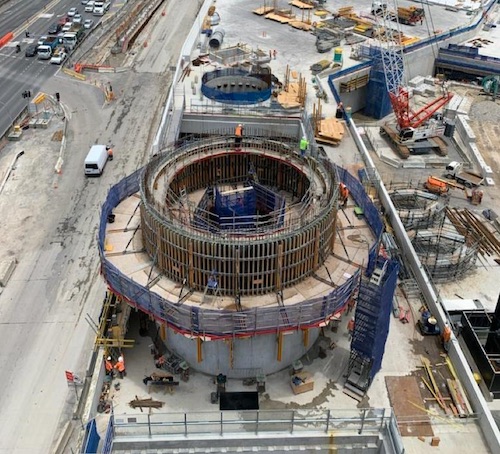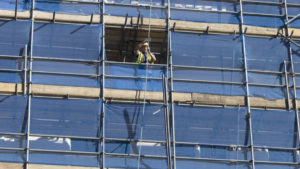Acrow CEO Steven Boland: Great place to be as infrastructure will boom for another decade

Picture: Getty Image
It’s possibly the best time to be in the civil infrastructure space right now, with billions of tax dollars pouring into public projects across Australia.
Major public works are simultaneously being conducted to build and upgrade our rail, road and utilities infrastructure – both in regional and coastal areas.
It’s all part of the Government’s 10‑year infrastructure pipeline that has seen $120 billion committed to infrastructure projects since the Coalition took power.
And the best thing about it? There’s probably going to be at least another 10 years of really solid growth.
That’s the assessment of Steven Boland, the CEO of Acrow Formwork and Construction (ASX:ACF), a leading provider of scaffolding and formworks in the country.
“We’ve got another decade of this sort of activity around civil projects,” Boland told Stockhead.
“Many people think this is going to be peaking in the next few years, but I don’t think we’re going to get that peak,” he added.
“I think it’s going to be a flatter and longer peak, and we won’t see that peak for another decade.”
Where the government projects are
Most of the $17.9 billion Budget allocated by the Treasurer this year has gone to projects in the east coast of the country.
In NSW, $3.6 billion has been granted to upgrade the Sydney to Newcastle rail line, which also includes a faster Tuggerah to Wyong regional line.
In Qld, more than $2.6bn was allocated to build a new rail line from Brisbane to the Sunshine Coast, which includes an upgrade to the Brisbane – Gold Coast rail route.
In Vic, a total of $3.5 billion will be spent towards projects such as the Beveridge Interstate Freight Terminal, including the proposed connecting roads to it.
“And you’ve also got one of the biggest road projects in the country at the moment – which is the Western Distributor project in Melbourne where they’re currently building a tunnel under the West Gate Bridge,” Boland said.
“When you think about it, Brisbane, Sydney and Melbourne are all building new underground rail networks all at the same time. And that hasn’t been done for 30 or 40 years,” he added.
At the moment, around 50% of Acrow’s revenue is coming from government-funded civil infrastructure projects in those three states.
“Those are multibillion projects with huge headline numbers, but Acrow might get $20 million or $30 million worth of revenue slice from those projects,” Boland added.
Acrow has secured seven key contract wins over the past year.
Those wins include the provision of scaffolding for the Snowy Hydro 2.0 Project in NSW, and the installation of a 120-tonne Ringlock scaffold at the Olympic Dam in South Australia.
The company’s engineering prowess, however, is in the design of bespoke formworks, such as the ones used in the Western Distributor Project and Rozelle Vent Shafts.

“These formworks are not meat and potatoes, they’re very highly bespoke and engineered by our team. If we can come up with the right design, we save them a lot of money in labor and crane time,” Boland explained.
The next decade
There are also major civil projects currently happening to connect regional Australia to the digital economy.
The plan includes a $1.3 billion upgrade to the NBN fixed wireless and satellite networks for up to 1 million regional users.
It also includes an expansion of mobile coverage in regional areas, as well as projects to improve resilience to natural disasters.
“The macro environment we’re seeing is that population growth has outgrown our ability to service people with our existing transport and utilities infrastructure,” Boland said.
“And these new programs are not going to disappear even if we have a change of government at the federal or state level,” he added.
“It’s a truly a great period to be working in a business that focuses on civil infrastructure, and this will continue to play out over the next decade.”
Acrow share price today:
Other ASX infrastructure stocks to watch
Two of the giants in this space are Cimic Group (ASX:CIM) and Boral Ltd (ASX:BLD).
Cimic has major projects in Sydney which include the Sydney Metro, Western Sydney Airport and the Western Harbour Tunnel. Its contract wins for the first quarter amounted to over $4 billion.
Meanwhile Boral’s major projects in Australia include the Western Sydney Airport terminals, and Tonkin Gap in Western Australia. Its total revenue for the half was $2.4 billion which includes revenue from concrete and quarries sales.
Other companies in this space include:
NRW’s business is structured into civil, mining, minerals, energy & technologies, and drill & blast, operated through group entities.
In February last year NRW acquired Primero Group – an EPC (engineering, procurement, construction) business that operates in the mineral processing, energy and non-process infrastructure market segments as a turnkey solution provider.
SRG Global is a mining services and construction group operating across the entire asset lifecycle of engineer, construct and sustain.
Earlier this month SRG signed a sale implementation deed to acquire WBHO, South Africa’s leading infrastructure contractor and the owners of Probuild, for $15.2 million.
In the telco space, infrastructure stocks to watch may include:
Ausnet owns and operates Victoria’s electrical transmission network, and distributes electricity to individual homes.
An interesting fact about Ausnet’s share register is that it’s predominantly held by foreign companies, with Singapore Power and State Grid of China topping the register list.
Swoop recently snapped up regional wireless broadband provider, Speedweb.
The $1.75 million acquisition gave Swoop access to Speedweb’s network of over 50 towers and masts that provide high speed wireless broadband in the regional areas of Gippsland and Latrobe Valley of Victoria.
Share prices today:
Related Topics
UNLOCK INSIGHTS
Discover the untold stories of emerging ASX stocks.
Daily news and expert analysis, it's free to subscribe.
By proceeding, you confirm you understand that we handle personal information in accordance with our Privacy Policy.








